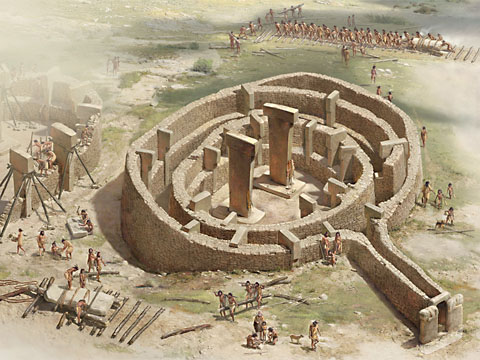
Χριστος (Christos) means the Anointed One, and was the basis for the original Christian symbol, the juxtaposed
Chi-Rho. By this sign, early Christians could identify themselves both as followers of a particular Anointed One, and as anointed ones themselves.
Anyone who has been through the sacrament of baptism is an anointed one, an initiate of the Christian Mysteries — which is exactly what they were in the early years of what is called the Common Era. (I actually prefer Anno Domini, because at least that doesn't try to evade the question of where, which is to say from what religion, the western dating system comes from.) Christian initiation came to literally embody the journey from birth to death, and an initiation into Christian mysticism became an enlightened journey starting at a spiritual rebirth, one which took place, at minimum, at the age of majority.
The
Chi-Rho symbol may have also been widely recognized in the Roman era as a figurative representation of a person on a cross, if
Simcha Jacobovici is correct in his theory that Roman crucifixion was actually done using x-shaped crosses instead of t-shaped ones. Today the
Chi-Rho can still be seen in liturgical use even in the shadow of the crucifix which has since been transformed into its more recognizable image.
Though Christianity is still
occult in many practices, as anyone who has been to a Tridentine Sacrifice of the Mass can attest, it has also positioned itself as the enemy of
occultism the further it has moved away from being a secretive fraternity. Christianity, in effect, has long since become a religion, not a brotherhood. Apart from much ballyhooed examples of masonic messages preserved in stone and stained glass, Christianity's metamorphosis has taken it from hidden meaning to a common faith of uncommon language.
Yet at the crucible point of Lutheranism, Rosicrucianism arose to simultaneously call for universal reformation and to cloak its summons in the language and symbolism of elite learned men. What can be made of this seeming contradiction ?
In the 17th century, Latin — not the languages of Germans, or Huguenots, or the English Reformation, or Muslims or Chinese for that matter — was still the language by which "proper learning" was transmitted. Publishing in Latin was a way of proclaiming "this is legit," and it still is in some cases. If you've ever heard the name of
tyrannosaurus rex, you probably see what I mean.
Liberatio per artem et scientiam — liberation through art and knowledge. If I were to start a Rosicrucian Order of my own, this might be its motto. For those of us in the West, "science" is the term we use to describe that which can be known ; "art" is the term by which we describe that which could not otherwise be known.
Another word I like, which could be described as a translation of "Rosicrucian" (though perhaps by no one but me) is 芸者 (geisha) — one whose entire life could be described as an ongoing work of art.
If the term Rosicrucian does not describe someone of continual seeking and learning and absorbing things foreign to them, and expressing those thing in multiple esoteric and exoteric ways, then I don't know what it means.
 I googled "first rosicrucian" and the first like that popped up said "Understanding reincarnation" which leads me to the topic of today's post: Pythagoras.
I googled "first rosicrucian" and the first like that popped up said "Understanding reincarnation" which leads me to the topic of today's post: Pythagoras.





































:max_bytes(150000):strip_icc()/300px-Iphigenia-56aaa46e3df78cf772b45e7c.jpg)
:origin()/pre00/638c/th/pre/f/2014/079/0/5/two_prayers_to_sekhmet_by_tuffhoss-d7b0c5k.jpg)

